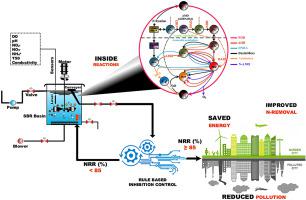Renewable and Sustainable Energy Reviews ( IF 15.9 ) Pub Date : 2020-08-18 , DOI: 10.1016/j.rser.2020.110126 Amarpreet Singh Arora , Alam Nawaz , Muhammad Abdul Qyyum , Sherif Ismail , Muhammad Aslam , Ahmed Tawfik , Choa Mun Yun , Moonyong Lee

|
The intensification of anaerobic ammonium oxidation (anammox) research immediately after its discovery in 1995 can largely be attributed to its low sludge production and aeration requirements, making it an economically energy efficient and eco-friendly technology with high potential for bioenergy recovery. However, anammox activity could be inhibited in waste streams containing highly variable compounds, such as free ammonia (FA), dissolved oxygen (DO), nitrite (), toxic and non-toxic organic matter (OM), salts, heavy metals, sulfide, and phosphate. Moreover, the long start-up period of anammox consortia is the main drawback of the process. Hence, careful control and mitigation of inhibiting factors is important for the successful use of this technology. This review provides a comprehensive understanding of the inhibition mechanism, threshold concentrations, and control strategies involved in ensuring the proper functioning of the anammox system. Knowledge and rule based state-of-the-art control strategies have been proposed, which will lead to successful operation and maintenance of anammox-based systems. These strategies will act as guidelines for the operators to address system irregularities at the earliest, thus preventing serious damage to the overall functioning of the system. Finally, key bottlenecks and innovative prospects that require attention, in order to achieve practicality and universal use of anammox-based technologies are highlighted.
中文翻译:

基于节能厌氧氨氧化技术的废水脱氮和生物能回收:抑制机理,最新控制策略和前景
自1995年发现厌氧铵氧化(anammox)以来,研究的迅速加强在很大程度上归因于其对污泥的产生和曝气的要求低,使其成为经济高效,生态友好的技术,具有很高的生物能回收潜力。但是,在含有高度变化的化合物(例如游离氨(FA),溶解氧(DO),亚硝酸盐(),有毒和无毒有机物(OM),盐,重金属,硫化物和磷酸盐。而且,厌氧菌团的启动时间长是该方法的主要缺点。因此,仔细控制和减轻抑制因子对于成功使用该技术很重要。这篇综述对抑制机制,阈值浓度以及确保厌氧氨氧化系统正常运行所涉及的控制策略提供了全面的了解。已经提出了基于知识和规则的最新控制策略,这将导致基于厌氧氨纶的系统的成功运行和维护。这些策略将作为操作员尽早解决系统不规则问题的指南,从而防止严重损害系统的整体功能。最后,



























 京公网安备 11010802027423号
京公网安备 11010802027423号